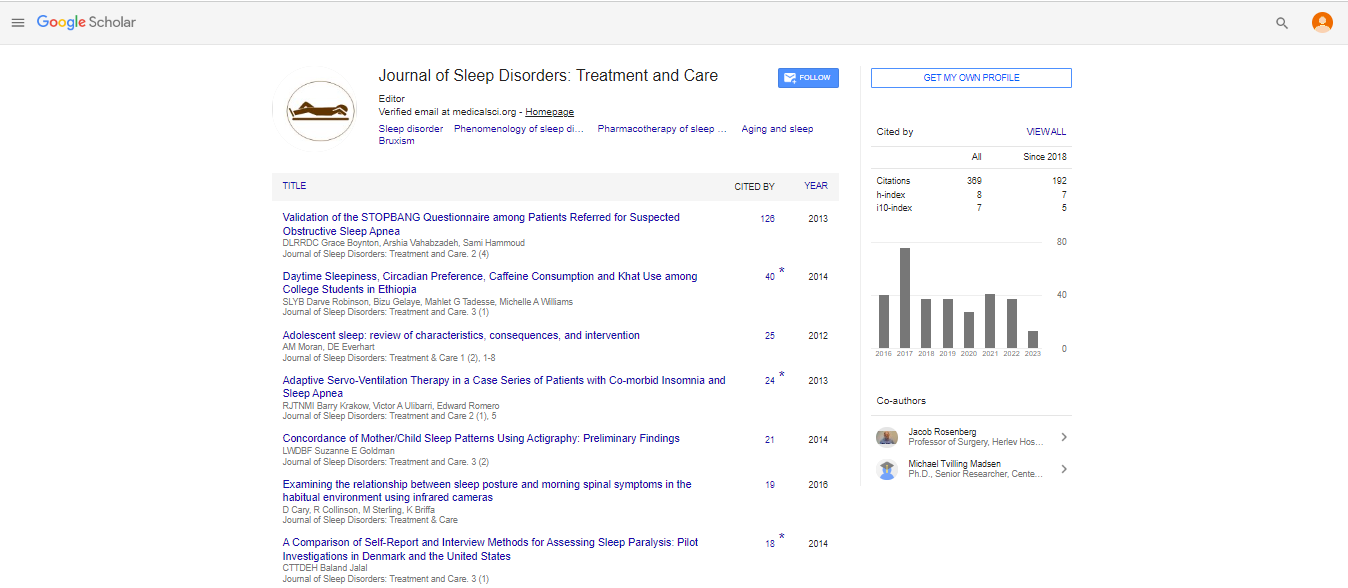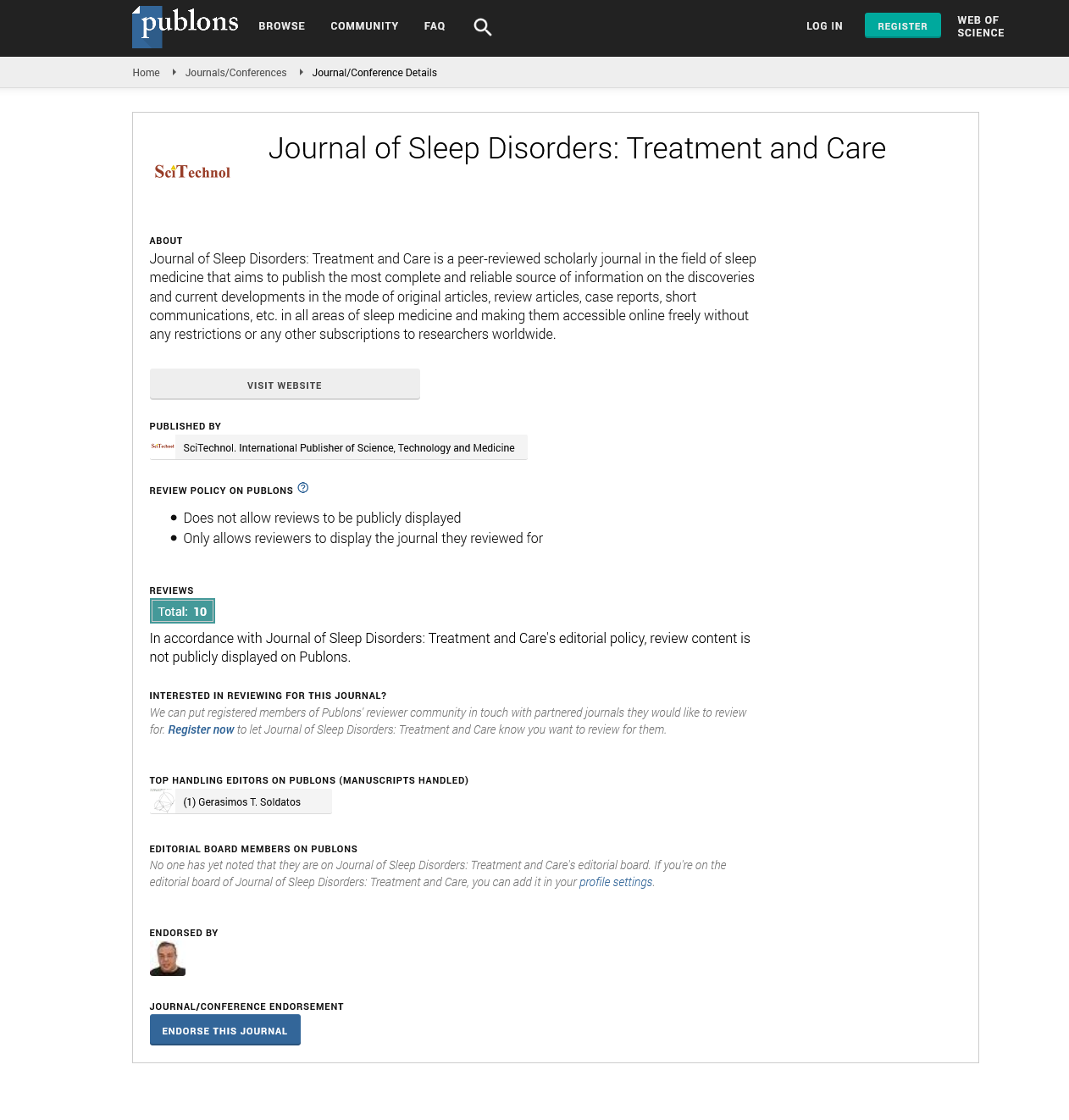Opinion Article, J Sleep Disor Treat Care Vol: 13 Issue: 2
Managing Sleep Apnea and Restless Leg Syndrome in Affected Patients
Colin Bruce*
1Department of Neurosciences, Aston University, Birmingham, United Kingdom
*Corresponding Author: Colin Bruce,
Department of Neurosciences, Aston
University, Birmingham, United Kingdom
E-mail: colin@gmail.uk
Received date: 25 November, 2024, Manuscript No. JSDTC-24-155835;
Editor assigned date: 27 November, 2024, PreQC No. JSDTC-24-155835 (PQ);
Reviewed date: 11 December, 2024, QC No. JSDTC-24-155835;
Revised date: 17 December, 2024, Manuscript No. JSDTC-24-155835 (R);
Published date: 24 December, 2024, DOI: 10.4172/2325-9639.1000171.
Citation: Bruce C (2024) Managing Sleep Apnea and Restless Leg Syndrome in Affected Patients. J Sleep Disor Treat Care 13:2.
Abstract
Description
Sleep Apnea and Restless Leg Syndrome (RLS) are two common sleep disorders that can significantly impact a person's quality of life. When both conditions co-occur, they can exacerbate each other, leading to more severe symptoms such as persistent daytime fatigue, poor sleep quality and difficulty concentrating. Effectively managing these conditions requires a comprehensive, multidisciplinary approach that addresses both the underlying causes and the symptoms of each disorder. Restless Leg Syndrome (RLS), on the other hand, is a neurological disorder characterized by an extreme urge to move the legs, typically accompanied by uncomfortable sensations like tingling, crawling or aching.
Restless legs syndrome is a common condition that can affect anyone at any point in their life. But, women are twice as likely to develop restless legs syndrome as men. The overlap of these two disorders is not uncommon. RLS can lead to frequent awakenings throughout the night, making it harder for individuals with sleep apnea to get restful sleep. Conversely, the fragmented sleep caused by sleep apnea can worsen the symptoms of RLS, creating a vicious cycle of poor sleep and persistent discomfort. Proper management of both conditions is essential to break this cycle and improve the patient's overall well-being. RLS symptoms are most pronounced during periods of inactivity, such as when lying down to sleep, making it difficult for individuals to fall or stay asleep.
Polysomnography or a sleep study, is often used to diagnose sleep apnea. It records brain activity, eye movements, muscle activity and respiratory patterns to monitor breathing disruptions during sleep. Meanwhile, RLS is typically diagnosed based on clinical symptoms and patient history, although iron deficiency or neurological abnormalities may also be studied as contributing factors. Lifestyle Changes, Patients with both conditions benefit from maintaining good sleep hygiene. This includes sticking to a consistent sleep schedule, avoiding caffeine or alcohol before bed and creating a calm and comfortable sleep environment. Limiting screen time and incorporating relaxation techniques, such as deep breathing or meditation, can also promote better sleep quality.
Physical Activity and Stretching, Regular physical activity is beneficial for both sleep apnea and RLS. Exercise can improve sleep quality; reduce the severity of RLS symptoms and help with weight management, which can alleviate sleep apnea. Gentle stretching exercises before bed, especially focusing on the legs, may also provide relief for RLS. Combination Therapies, a combination of treatments may be necessary for individuals who suffer from both conditions. For example, combining CPAP therapy with medications for RLS can significantly improve sleep quality and reduce the impact of both disorders. In some cases, Cognitive Behavioral Therapy for Insomnia (CBT-I) may be recommended to help patients cope with the emotional toll of chronic sleep disruption.
Managing the dual challenges of Sleep Apnea and Restless Leg Syndrome requires an integrated, patient-centered approach. By addressing both the underlying sleep disruption caused by sleep apnea and the discomfort of RLS, healthcare providers can significantly improve a patient's sleep quality, reduce daytime fatigue and enhance their overall quality of life. Early diagnosis, a combination of medical therapies, lifestyle adjustments and ongoing monitoring are essential components of effective treatment for individuals affected by both disorders. With the right care, patients can break the cycle of disrupted sleep and achieve more restful, restorative nights.
 Spanish
Spanish  Chinese
Chinese  Russian
Russian  German
German  French
French  Japanese
Japanese  Portuguese
Portuguese  Hindi
Hindi 
